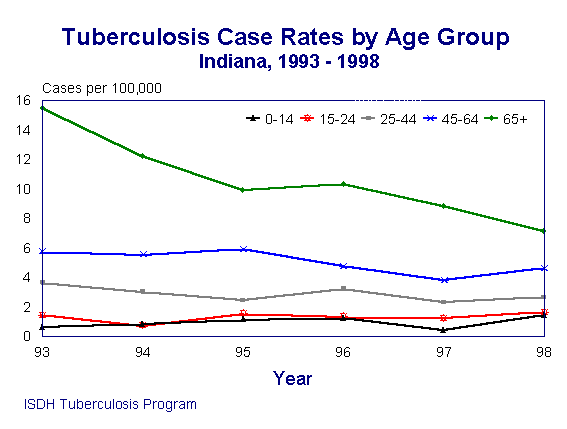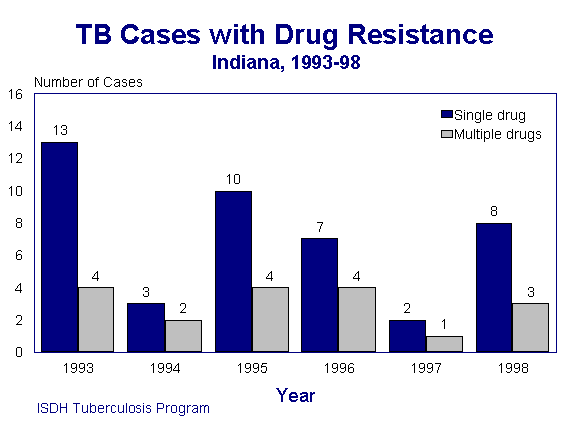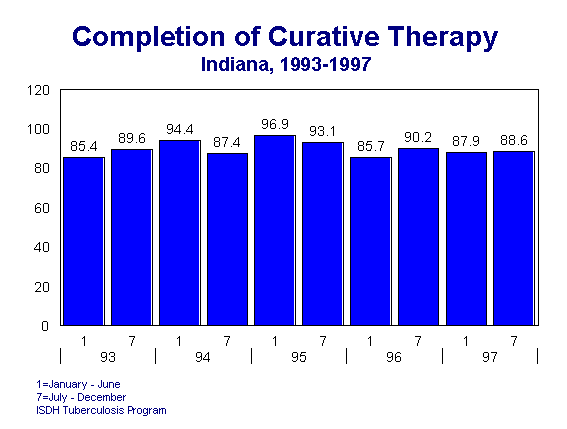
TUBERCULOSIS
Cases
= 188White = 1.8
Black = 11.6
Asian = 28.1
Hispanic = 16.1
Gender-specific Rates per 100,000 population
Female = 2.6
Male = 3.8
Tuberculosis (TB) is an airborne disease caused by Mycobacterium tuberculosis. General symptoms associated with TB are productive cough, coughing up blood, night sweats, fever, and malaise. TB usually affects the lungs, but can also affect other parts of the body such as the brain, kidneys, or spine. TB bacilli are put into the air when a person who has TB of the lungs or larynx coughs, sneezes, laughs, or sings. The bacilli are then inhaled by another person. Individuals who inhale TB bacilli are considered to have TB infection and cannot transmit the infection to others. Some individuals who harbor the bacilli will progress from the stage of TB infection to active disease. These individuals are cases of TB and can transmit TB to others. The bulk of this report concerns cases of TB disease.
During 1998, 188 new cases (Figure 1) of tuberculosis were reported to the Indiana State Department of Health (ISDH). This represents an 11% increase from the 168 cases reported in 1997. The state case rate was 3.2 cases per 100,000 population. The 1997 U.S. Bureau of the Census, inter-census estimates were used to calculate the rates reported in this document. TB was reported by 45 (48%) of the 92 counties. Generally, cases were associated with the urban and suburban counties. With the advent of chemotherapy, TB can and is treated on an out-patient basis. Chemotherapy has led to a dramatic decline in the number of deaths due to TB disease. During 1993-1997, an average of 21 deaths was attributed to TB in the state of Indiana. The number of Hoosiers who have died from TB over the past several years, as shown in Figure 2, serves as a stark reminder that TB is still a deadly disease.
Figure 1.

Figure 2.

In order for a person diagnosed with TB to be counted as a TB case, the medical record is reviewed by the local health official who is familiar with TB. If the medical history and clinical findings meet the predetermined case criteria, it is counted as a new TB case. The culture identification of Mycobacterium tuberculosis complex includes three species important in human disease: M. tuberculosis, M. bovis, and M. africanum. The case data in this report are compiled from the reports submitted through local health departments to ISDH. The cases are verified and categorized as confirmed, clinical or provider diagnosis. "Confirmed" cases are those in which M. tuberculosis has been isolated from a clinical specimen OR M. tuberculosis has been demonstrated in a clinical specimen by a nucleic amplification (NAA) test OR acid fast bacilli (AFB) are seen when a culture has not or cannot be obtained. A "Clinical" case is one in which the individual has a positive tuberculin skin test, an abnormal chest x-ray, symptoms suggestive of TB disease, and improves on anti-TB therapy. The third category is "Provider Diagnosis". This category includes those cases where the physician has determined the patient has TB, is treating with an appropriate drug regimen, and the patient is improving clinically on this regimen. Many in this category include extra-pulmonary TB where laboratory confirmation may be lacking due to the site of the disease and children in whom obtaining specimens is difficult and invasive procedures are not warranted. Table 1 summarizes the reported TB cases by verification criteria. Since these data are collected by "date reported," the totals are similar, but do not equal the calendar year totals that reflect the date the case was counted as a surveillance case.
Table 1.
Summary of TB Case Verification
Indiana, 1993-1998
Verification Category |
1993 |
1994 |
1995 |
1996 |
1997 |
1998 |
Confirmed by Positive Lab Tests |
199 |
165 |
149 |
156 |
138 |
141 |
Clinical Case |
36 |
29 |
37 |
29 |
25 |
24 |
Provider Diagnosis |
9 |
14 |
11 |
17 |
7 |
21 |
As in years past, more males were diagnosed with TB than females (Figure 3). In 1998, males represented 58.0% of the newly diagnosed TB cases. The case rate per 100,000 population was 3.8 for males and 2.6 for females.
Figure 3.

Case rates per 100,000 population by race and ethnicity were 1.8 for Whites, 11.6 for Blacks, 16.1 for Hispanics, and 28.1 for Asians. Although foreign-born persons had the greatest rates of TB, the number of foreign-born persons living in Indiana remains relatively small. For this reason, the rates in this group may be unstable.
In 1998, 19.2% (36/188) of cases were foreign-born which means the country of origin was a country other than the US (Figure 4). Among the foreign born, Latin America accounted for 44% (16/36) of the cases. These individuals came from Mexico (15) and Honduras (1). Asia accounted for 39% (14/36) of the foreign-born cases with patients coming from Vietnam (4), the Philippines (3), China (2), Burma (2), Korea (1), Guam (1), and Bangladesh (1). The Mideast represented another 14% (5/36) with patients from Russia (2), India (2), and Afghanistan (1). The remaining 3% (1/36) came from Guinea (1).
Figure 4.

In Indiana, the incidence of TB has been higher in older individuals (Figure 5). The case rate in this group has steadily declined. In 1998, 27.7% of the cases were over age 65 with a case rate of 7.1 per 100,000. Of the total 188 total cases reported, 30.3% were age 45-64 with a case rate of 4.6. The age group of 25-44 represented 25.5% of the case for a case rate of 2.6, and 7.0% were age 15-24 for a case rate of 1.6. This year, 9.0% were under the age of 14 for a case rate of 1.4.
Figure 5.

Seventeen children under the age of 15 were diagnosed in 1998 (Figure 6). Four children were four years of age or younger. TB in young children is considered a sentinel event, representing failure to interrupt the transmission of TB, usually from an adult to a child.
Figure 6.

Several risk factors are associated with the development of TB disease or progression from infection to disease. The most important of these factors is HIV disease. In 1998, there were nine individuals diagnosed with both TB and HIV (Figure 7) compared to the four dually infected individuals in 1997. During 1998, HIV status was only known for approximately 10% of the cases. HIV status was unknown or the test was not offered in the great majority of the cases. Due to the small numbers of individuals diagnosed with both TB and HIV, significant variation in the numbers of cases identified can be expected to occur due to chance alone. National guidelines recommend HIV counseling and testing for all patients with TB.
Figure 7.
Other risk factors associated with TB are alcohol use, homelessness, illicit drug use (injecting and non-injecting), residence in a long term care (LTC) or correctional facility, or employment as a health care worker (HCW). The breakdown can be see in Table 2.
Table 2.
Number of Reported Tuberculosis Cases
by Risk Factor, 1998 (n=188)
Risk Factor |
Number of Cases |
Percent of Total Cases |
Alcohol use |
9 |
4.8% |
Homelessness |
7 |
3.7% |
Illicit drug use |
8 |
4.3% |
LTC resident |
5 |
2.7% |
Health care worker |
6 |
3.2% |
Inmate |
6 |
3.2% |
Unknown |
18 |
9.6% |
No risk factor identified |
129 |
68.6% |
Occupation is another variable used to detect trends. Compilation of these data show that 55.9% of the individuals diagnosed with TB disease were unemployed and 30.9% had known employment (Table 3). The "unemployed" category includes retired persons, children, and students. Six health care workers were diagnosed with disease in 1998.
Table 3.
Number of Reported Tuberculosis Cases
by Occupation, 1998 (n=188)
Occupation |
Number of Cases |
Percent of Case |
Unemployed |
105 |
55.9% |
Other occupations |
52 |
27.7% |
Unknown |
24 |
12.8% |
HCW |
6 |
3.2% |
Corrections |
0 |
0% |
Of the 188 cases reported in 1998, 78.2% (147/188) were pulmonary. Pulmonary cases are of particular concern since these individuals may actively transmit the disease to others. To break this cycle of transmission, appropriate and adequate therapy must be initiated and continued for the duration of the treatment period. ISDH follows the 1994 guidelines set by the American Thoracic Society/Centers for Disease Control and Prevention (ATS/CDC) which recommends at least three drugs in the initial regimen. Table 4 shows the impact of those guidelines on the prescribing practices of physicians before and after the new guidelines were adopted. In 1998, 90.4% (170/188) of the cases initiated therapy on a drug regimen containing three or more drugs and only 5.9% (11/188) were started on a two-drug regimen. Seven cases were reported at the time of death or were dead at the time of diagnosis. No drugs were started in these seven instances. A post-mortem diagnosis of TB suggests that there may have been a delay in the TB diagnosis. Disease transmission may not have occurred before anyone suspected TB. Contact investigations based on the late diagnosis are crucial to protect the survivors.
Table 4.
Summary of Initial Drug Regimen
Indiana, 1993-1998
Initial Drug Regimen |
1993 |
1994 |
1995 |
1996 |
1997 |
1998 |
| No drugs | 16 |
8 |
5 |
7 |
7 |
7 |
| One Drug | 5 |
0 |
1 |
1 |
0 |
0 |
| Two Drugs | 62 |
30 |
17 |
24 |
15 |
11 |
| Three or More Drugs | 165 |
173 |
176 |
170 |
146 |
170 |
Drug susceptibility testing is recommended for all cultures positive for TB to detect any resistance to the medications prescribed. Of the reported 188 TB cases, 5.9% (11/188) had resistance to at least one anti-tuberculous drug. In 1998, susceptibility testing was performed on 82.1% (124/151) of initial positive cultures. When specimens are submitted to the State TB Laboratory, drug susceptibility is automatically done on all positive cultures. Private laboratories require that drug susceptibility studies be specially requested as they are not routinely performed. Multi-drug resistant (MDR) TB is defined as resistance to both isoniazid and rifampin. MDR-TB is of particular public health concern since these two drugs are the most effective medications used to treat TB. If the organism develops resistance to these two medications, they no longer will be effective to treat this disease, thus limiting the arsenal of drugs shown to be effective in the treatment and management of TB. There was only one case of MDR-TB in 1998 and was in a foreign-born individual.
INH-resistant TB is treatable and curable with the standard four-drug regimen. Close and careful monitoring of these patients is necessary to prevent additional drug resistance. Drug resistance was documented in Allen County (Isoniazid), Delaware County (Isoniazid), Elkhart County (Streptomycin), Grant County (Isoniazid, Ethionamide), Henry County (Streptomycin), Lake County (Isoniazid), Marion (Streptomycin), Noble County (Isoniazid, Streptomycin), Steuben County (Isoniazid) and Vigo County (MDR-TB). If resistance to rifampin or pyrazinamide is present, length of treatment must be prolonged. The number of drug resistant cases since 1993 is shown in Figure 8.
Figure 8.

Besides drug resistance, non-compliance is another major reason for having to extend the treatment period. The most effective method to assure the patient is complying with the prescribed regimen is to use Directly Observed Therapy (DOT). DOT is a strategy proven to ensure completion of therapy, thereby preventing the emergence of acquired drug resistance. DOT should be considered for all TB patients. Every effort must be made to initiate DOT when the patient is first started on anti-TB medications, especially pulmonary and drug resistant cases. During 1998, 66.0% (122/188) of all cases were on DOT for some portion of the treatment period (Figure 9).
Figure 9.

The top priority of TB control and prevention efforts is to ensure completion of therapy in TB patients. Indiana’s objective is to have at least 90% of all patients complete an adequate and appropriate course of therapy. The completion of therapy index is calculated for groups of cases by dividing the number of cases who complete therapy by the total number of cases who are expected to complete therapy within the designated time period. Exclusions are deducted from the denominator and are not included in the rate calculations. Exclusions from the rate calculations are those cases reported at the time of patient death, cases that were never started on therapy, and cases with death during therapy. Therapy is considered to be incomplete for those patients who were reported as moved, uncooperative or refused, or disposition unknown.
In previous years, the statistics for Marion County had been reported separately from the rest of the State. Due to changes in how the Centers for Disease Control and Prevention calculates completion rates, the two entities will be reported in combined figures. This combination of reporting areas is consistent throughout the nation so that states can compare the data.
Because completion data are gathered at the end of therapy, the current data are for those patients who initiated therapy in 1997. During the first half of the year, the state completion rate was 87.9% and 88.6% for the second half. These data from 1993-1997 have been recalculated and the revised rates are shown in Figure 10.
Figure 10.

The second priority in TB control and prevention is to identify those individuals who are infected with TB and could benefit the most from preventive therapy. Those individuals who have had recent contact with a known TB case, individuals who have converted their skin test within the last two years, individuals from high risk groups, and individuals whose immune system may be compromised for any reason will derive the greatest benefit from early detection and preventive therapy. The best means of identifying exposed and infected individuals is to perform a complete and thorough contact investigation. During 1998, 147 pulmonary cases were diagnosed. Due to staffing changes and a conversion to a different software program, contact investigation and follow-up data collected at the State level are incomplete at the time of publication. Contact identification information has only been received for 68 cases or 46.3% of the infectious pulmonary cases.
Based on the available information reported to the State, eight contacts were found to have active TB disease and were identified as a result of the contact investigation. Based on national estimates, each infectious case averages nine contacts, 21% of whom are infected, and 1% found to have disease when identified as a contact. Of the contacts examined during 1998, 8.8% were diagnosed with TB infection. Of those individuals, 39.0% were started on preventive therapy. Contacts of known TB cases are at greatest risk for developing active TB disease; therefore, current treatment guidelines say to offer preventive therapy to all contacts regardless of age. Children under the age of 15 represented 5.0% of the infected contacts and 91.0% were started on preventive therapy.
Completion of preventive therapy rates for contacts is tracked by age. The completion of preventive therapy is calculated much the same was as completion of curative therapy. The number of patients who are reported as having completed a course of preventive therapy is divided into the number of patients who are expected to complete therapy. The exclusions are those who develop active disease, death during therapy, discontinued therapy due to adverse reactions, or if the individual moved out of jurisdiction. The rates in the chart below have been recalculated to reflect the combined data for the State and Marion County. During the first half of 1997, the State completion rate for contacts under the age of 15 was 50% and increased to 69.3% the second half of the year (Figure 11). For those aged 15 and older, the State completion rates were 80.5% and 71.4% (Figure 12).
Figure 11.


Figure 13 gives an overview of where the TB cases occurred geographically within the state. The numbers represent the number of cases in each county with the number of drug resistant cases in the dark square. TB was reported by 45 of the 92 (48%) Indiana counties. Eleven drug resistant cases were reported in ten different counties.
Figure 13.